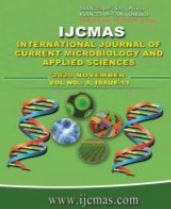


 National Academy of Agricultural Sciences (NAAS)
National Academy of Agricultural Sciences (NAAS)

|
PRINT ISSN : 2319-7692
Online ISSN : 2319-7706 Issues : 12 per year Publisher : Excellent Publishers Email : editorijcmas@gmail.com / submit@ijcmas.com Editor-in-chief: Dr.M.Prakash Index Copernicus ICV 2018: 95.39 NAAS RATING 2020: 5.38 |
The study was conducted at the Seed Testing Laboratory, Department of Genetics and Plant Breeding, Sam Higginbottom University of Agriculture, Technology and Sciences, Prayagraj, Uttar Pradesh, during 2019-2020. The lentil of variety K-75 was treated with different methods of priming viz. control, distilled water (hydro priming), GA3(hormonal priming), PEG 6000 (osmo priming), KH2PO4, KNO3, KCl, ZnSO4 (halo priming), Tulasi Leaf Extract, Moringa Leaf Extract and Neem Leaf Extract (organic priming) for 12 hours and were shade dried for further experiment. The experiment conducted was analysed by completely randomized design (CRD) with four replications. The quality parameters which were analysed for different treatments was germination percentage, speed of germination, root length (cm), shoot length (cm), seedling length (cm), seedling fresh weight (g), seedling dry weight (g), seedling vigour index I and seedling vigour index II. The experiment showed the organic treatment i.e. Neem Leaf Extract (NLE) attained the highest value in germination percentage, speed of germination, root length, shoot length, seedling length, seedling fresh weight, seedling dry weight, seedling vigour index I and seedling vigour index II. Hence, the results concluded that the organic priming treatment (NLE) was found to be better and can be effectively used as low cost, environmentally friendly, easily adaptable priming method by farmers.
 |
 |
 |
 |
 |